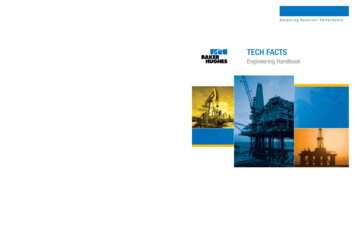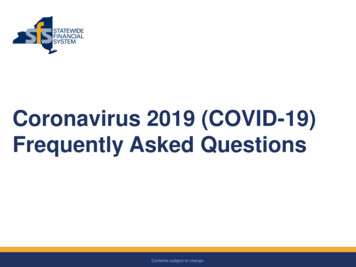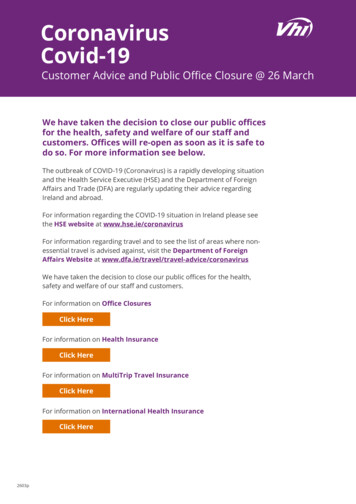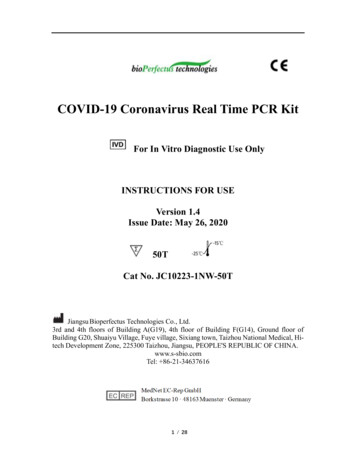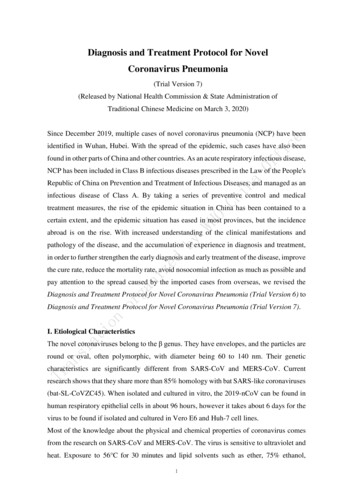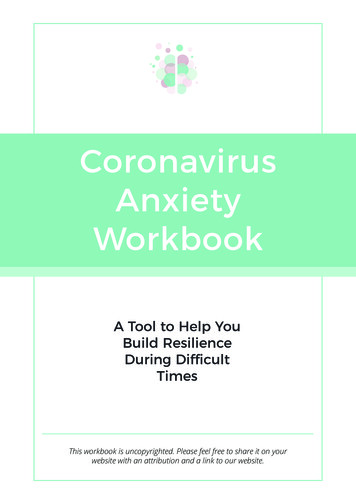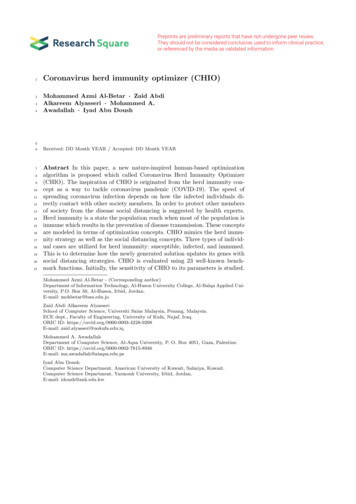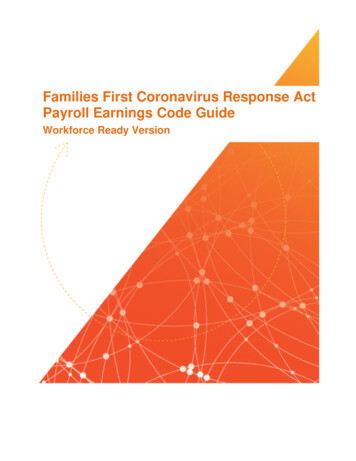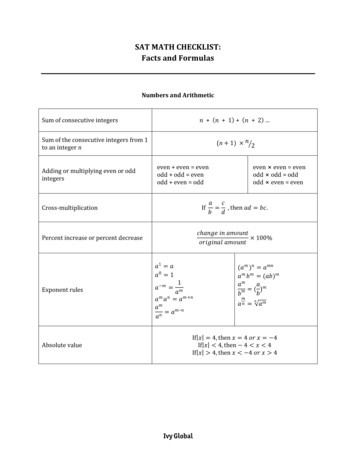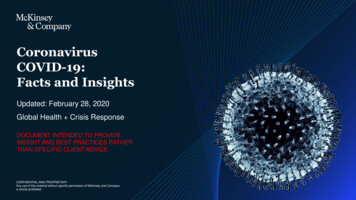
Transcription
CoronavirusCOVID-19:Facts and InsightsUpdated: February 28, 2020Global Health Crisis ResponseDOCUMENT INTENDED TO PROVIDEINSIGHT AND BEST PRACTICES RATHERTHAN SPECIFIC CLIENT ADVICECONFIDENTIAL AND PROPRIETARYAny use of this material without specific permission of McKinsey and Companyis strictly prohibited
CURRENT AS OF FEBRUARY 28, 2020 COVID-19 is, first and foremost, a humanitarian challenge. COVID-19 has affected communities onmultiple continents, with over 2,800 deaths out of over 82,000 reported cases. To date, Wuhan and Hubeiprovince have been the most affected locations. Thousands of health professionals are heroically battlingthe virus, putting their own lives at risk. Overstretched health systems mean that Wuhan and Hubei willneed time and help to return to a semblance of normalcy. Solving the humanitarian challenge is the top priority. Much remains to be done globally to respondand recover, from counting the humanitarian costs of the virus, to supporting the victims and families, todeveloping a vaccine. This document is meant to help with a narrower goal: provide facts and insights on the currentCOVID-19 situation to help decision-makers understand best practices. In addition to thehumanitarian challenge, there are implications for the wider economy, businesses, and employment. Thisdocument sets out some of those challenges and how organizations can respond in order to protect theirpeople and navigate through an uncertain situation.McKinsey and Company2
CURRENT AS OF FEBRUARY 28, 2020Executive summary (February 28, 2020)COVID-19 passed an inflection point this week, with more new cases outside China than in China for the first time. New cases increased 4.5x outside China, while those in China decreased 3x1 comparedto the previous week. However, China still reported more than 3,000 new cases, demonstrating that the epidemic is not over for them.The global surge reflects a new inflection point in this epidemic. Four ‘major transmission complexes’ (i.e., China, East Asia, Middle East, Europe) are now active, with the US at a tipping point.Governments globally are preparing for broader spread. Outside of China, deep economic connections and people movements within these complexes will make it difficult to stop intra-complex transmission – even asindividual regions go under lockdown, there are likely to be continued instances of viral “leakage”. This likelihood is enhanced by the disease’s inherent high transmissibility. Additional spread that creates new complexes isbeing considered an inevitability by governments around the world. The U.S. CDC, for example, has set clear expectations that the virus will appear there with community transmission. Scenarios to consider:[BASE CASE SCENARIO] Continued spread within established complexes plus community transmission in new complexes drives 0.3-0.7% reduction in 2020 global GDP growth China continues on its path to recovery, achieving a near-complete economic restart by mid-Q2 East Asia, Middle East, and Europe see continued case growth until early Q2. This drives each region to go under various forms of lockdown (e.g., self-imposed, company-imposed, mandated by local governments),in an attempt to stop or slow down the spread. The lockdown drives a sharp reduction in demand, which in turn drives lower economic growth that lasts through Q2 and early Q3. Demand recovery depends onwhether case growth reduces as a result of seasonality, or if fatality levels are low enough, where the general public resumes daily activities Complexes that have not yet seen sustained case growth (e.g., Americas) see localized transmission. Greater awareness of COVID-19, plus additional time to prepare, may help these complexes manage casegrowth. However, complexes with less robust health systems could see more general transmission, and bear the brunt of economic impact in early Q2 The impact on demand slows down growth of the global economy – between 1.8-2.2% instead of the 2.5% growth envisioned at the start of the year. Sectors are impacted differently – certain sectors (e.g., aviation,tourism, hospitality) see lower demand for a longer duration. For others (e.g., consumer goods), demand is initially lower but expected to rebound quickly[CONSERVATIVE SCENARIO] COVID-19 sees generalized, global spread through 2020, resulting in a demand shock that lasts for most of the year. In this scenario, the virus would not show significant seasonaleffects, or result in far higher transmissibility (e.g., through asymptomatic transfer), before health systems can detect and react to it effectively at scaleCompanies are still assessing the full impact of disruptions as COVID-19 continues to spread. Companies with strong, centralized procurement teams and good supplier relationships are feeling more confident inthe visibility to their suppliers at risk (including tier 2/3 ), but many companies are still grappling with their exposure in China and other transmission complexes. Given the relatively quick economic restart in China, manycompanies are focused more on temporary stabilization (e.g., parts rationalization, demand plan updates driving new production/ SKU plans, booking logistic capacity, other), rather than alternative suppliers outside China.Companies are, however, making strategic, longer-term moves that they were considering – with the COVID-19 outbreak as an accelerantGiven the rapid spread, companies could consider the following actions: Protect employees: Follow the most conservative guidelines among leading global and local health authorities (e.g., CDC, WHO). Communicate with employees frequently on decisions made, support any impactedemployees per health guidance. Benchmark efforts in terms of workplace actions Stand-up a cross-functional, global COVID-19 response team: Designate lead at the C-suite/CEO-1 level. Appoint 5 workstreams focused on (a) employees, (b) financial stress-testing and contingency plan, (c) supplychain, (d) customers; and (e) other relevant constituencies Protect customers: Protect customers (e.g., no penalties for cancellations, waiving fees); preserve customer loyalty (e.g., premium discounts); pursue online strategy as means of outreach Stress-test financials and liquidity, and create contingency plan: Model cash flow, P&L, balance sheet in each scenario; identify input variable triggers that could drive significant liquidity events (incl. breach ofcovenants). Identify critical operations, employees. Create pragmatic, trigger-based contingency plans. Conduct table-top exercises with top team . Maintain supply chain: Define extent and timing of Tier 1 / 2 exposure. Pursue immediate stabilization (e.g., critical parts rationing, pre-book freight capacity, plan for restart). Plan for how to manage a supply marketwith unusual spikes in demand, as supply comes back Demonstrate purpose: Support epidemic efforts where possible1.Accounting for new case definition. Source: World Health Organization Situation Reports, News reports, Internal McKinsey analysisMcKinsey and Company3
CURRENT AS OF FEBRUARY 27, 2020COVID-19Latest epidemiological information as of February 27, 2020Impact to date1 82,0002,800 47 1/2188Reported confirmed casesReproduction number5The average number of individuals infected from each infectedindividual55%Countries affectedProportion of affected countries with newcases in the last 7 days4Countries with any evidence of communitytransmission (Highest: China, S. Korea, Italy,Iran, Japan, Singapore)HHigh ( 4)GD Community transmissionsuspected in at least 18countries, with 50 cases: SouthKorea, Japan, Singapore, andItaly – a number of cases are stillunder investigation to identifysource of infectionNew reported cases are in China inthe last 7 days Oversight is intensifying inweaker health systems lesscapable of handling ARS-CoV(2-4)CZikaLow ( 2)Influenza H2N2 1957AInfluenza H1N1 2009Low ( 2%)EInfluenza 1918IEbola (West Africa 2014)Medium (2-15%)High ( 15%)Case fatality ratio3Proportion of deaths among confirmed cases1.5-2xUp to 20%Higher transmission compared to the flu2 1/40Patients die; fatality rates are significantlylower outside HubeiPatients have severe diseaseIdentification of cases early in the disease (i.e.,with fewer symptoms), intensification of viralcontrol methods, and deployment of treatments(when available) will drive down the reproductionnumber and reduce case fatalityLatest numbers are available from a number of sources, including daily situation reports from the World Health OrganizationEvidence on exact numbers are emerging, however expected to decrease as viral containment measures intensify and treatments are developedCase fatality numbers are reflective of the outbreak setting and depend on a number of factors, including patient's age, community immunity, health system capabilities, etc. This graphic aims tooffer a broad comparison.Excluding cruise ship5 In outbreak setting or at the beginning of the introduction of a new diseaseSource: World Health OrganizationNumbers of affected countrieshas risen significantly with 35countries with new cases in thelast 7 daysChickenpoxMediumCountries with more 50 reportedcasesFeatures of disease to date4. DeathsB1.2.3.Global considerationsComparison to other diseasesChina (outside Hubei) Daily incremental case countremains low for the last 7 days; 1 reported cases per million The number of confirmed casesreported is generally trendingdownMcKinsey and Company4
CURRENT AS OF FEBRUARY 27, 2020COVID-19 is spreading globallyand governments are respondingA rising number of countries show evidence of community transmission1 80% of cases throughcommunity transmission50-79% of cases throughcommunity transmissionAs the situation is evolving, we are learning more about the disease – anumber of unknowns remainDisease characteristicsImplicationsReproduction numberTransmissibility is expected to be less asoutbreak evolves and cases are identified early( - treatments / vaccines emerge)Reports from Cruise shipCalculations from academic publications (e.g., Nature,Imperial, NEJM, Lancet)20-49% of cases throughcommunity transmission1-19% of cases throughcommunity transmission0246Reported cases, 0% throughcommunity transmissionHigh uncertainty surrounding asymptomaticinfection rate due to missing data/evidenceAsymptomaticinfection rateReports from Cruise shipCalculations from academic publications (e.g., Nature,Imperial, NEJM, Lancet)Governments worldwide are reacting with different measuresSelected measures along the global regionsEast AsiaSouth Korea declared highest level threat “red alert”,closed schools and created “rapid response teams” forcluster investigationMiddle EastIran closed schools, universities and cultural centersSeveral countries partially closed borders (e.g., Armenia,Afghanistan, Iraq, Turkey, Pakistan)AfricaWHO helped to train 11,000 African health workers andshipped 30,000 sets of personal protective equipment1.0%10%20%30%High rates of asymptomatic infections warrantsadditional measures beyond traditionalscreening40%EuropeItaly signed an order issuing a ban to leave oraccess affected areas, suspension ofdemonstration and all kinds of events,suspension of childcare and school educationand quarantine for people in contactAmericaUSA implemented mandatory quarantine, airportscreenings, partial travel restriction, repatriationflights from areas with substantial COVID-19transmissions and stocked up on masks; generalpublic announcement made on need forpreparednessCorresponds to cases from reporting country not linked to Wuhan or travelers from WuhanSource: World Health Organization; Times; Bloomberg; Journal of American Medical Association, NatureCase fatality estimates1Actual death ratio may be lower due to highnumber of unreported cases that are generallymilder in symptomsCalculations for countries with 50 cases based onreported cases and deaths0%2%4%6%Correct number important to estimate severityof COVID-19Influenced by patient characteristics, countries'preparedness and health system capacities1 This is not a standard epidemiological measure - it is meant to reflect some of the ongoing challenges intracking the evolution of the disease; it does not correspond to Case fatality ratio, which requires better ofunderstanding of number of cases at the time of infection vs. death;McKinsey and Company5
CURRENT AS OF FEBRUARY 27, 2020Wuhan and Hubei continue to be deeply impacted The epicenter of the outbreak is facing emergency conditions and will need time to return to normalcyHumanitarian toll andeconomic impacts are high 59M200 Individuals underquarantineNew confirmed casesdaily11,700Health workerinfectionsMarch10Continued shutdownof businesses inHubei province21.2.3.A large effort has beenunderway to regain control 3 46 designated hospitals 20,000 beds devoted tovirus care Converted stadiums,office buildings,schools providingadditional beds 30,000 medical stafffrom across China havecome to Wuhan toprovide supportRefers to reported cases using new confirmed case definition, including clinical feature and laboratory-confirmed, latest available information available froma number of sourcesAs per Bloomberg, companies engaged in supply chain productionLatest update from 2/27/2020Source: Bloomberg, World Health Organization, Chinese press reports but Wuhan and Hubei will needtime to return to normalcy Infection rates remain high –Hubei has had between 200-800infections every day for the last 5days – far higher than 50-100 forthe rest of China combined Fatality rates are more than 3times higher in Hubei relative tothe rest of China – indicative of astretched medical system and / orchanging virus characteristics Once these measures are undercontrol, Hubei will need time to liftthe quarantine, disinfect andrestart safelyMcKinsey and Company6
CURRENT AS OF FEBRUARY 27, 2020 but February 24th represented an inflection point fo
28.02.2020 · McKinsey and Company 2 CURRENT AS OF FEBRUARY 28, 2020 COVID-19 is, first and foremost, a humanitarian challenge. COVID-19 has affected communities on multiple continents, with over 2,800 deaths out of over 82,000 reported cases.
